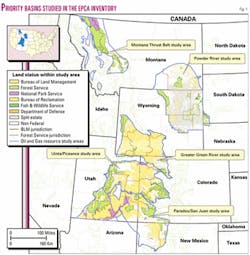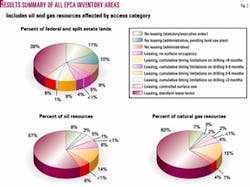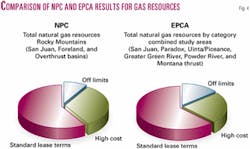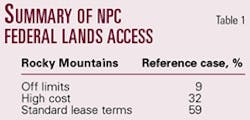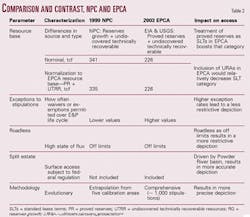As US energy needs grow, basins in the US West have been identified as a significant future supply source to help meet these needs, especially for natural gas.
Of the 23 tcf of gas that the US uses annually, about 4 tcf are imported. The US Energy Information Administration in its Energy Outlook 2003 projects that the demand for gas will rise to 35 tcf by 2025.
Basins in the Rocky Mountains represent the second largest gas resource in the US after the Outer Continental Shelf and can help meet this demand. While the resource base in the West is substantial, it is dominated by unconventional gas, primarily tight sands and coalbed methane.
At the same time, the Rocky Mountain region is one where multiple-use interests and environmental concerns often intersect. Multiple uses of the federal lands, including grazing, forestry, recreation, wildlife habitat, open space, wilderness, and rights-of-way, often conflict with exploration and production.
The restrictions and leasing stipulations that govern access to federal lands in the region are a patchwork of requirements that can act to increase costs and delay activity. Access restrictions range from areas unavailable for leasing, to areas where leasing can occur although the land surface cannot not be occupied, to limitations on drilling activities due to a variety of environmental considerations.
NPC assessment
In its landmark 1999 study,1 the National Petroleum Council provided a first-time assessment of gas resource impacts associated with federal land use designations and related environmental stipulations in the Rocky Mountain region.2
The NPC assessment was based on a limited sample of federal lands in the region. In that study, five specific areas were studied in detail and those results were extrapolated to all federal lands in the Rocky Mountains. The NPC assessment characterized access to gas resources as "off-limits," "high cost," or "standard lease terms" (Fig. 1). About 60% of gas resources were shown to be under standard lease terms. The NPC study recommended that the issue of land access be studied in more detail.
Mandate for EPCA
Recognizing the access situation, Congress directed that a scientific inventory of the nation's federal onshore lands be conducted to assess the impact of environmental considerations on the potential for recovery of oil and gas resources.
In November 2000, Congress passed (and Pres. Clinton signed) the Energy Policy & Conservation Act Amendments of 2000 (EPCA). Congress required that the analysis identify any restriction or impediment that might inhibit development of resources. Its purpose was to add clarity to the debate and assist energy policymakers and federal land managers in making decisions concerning oil and gas resource development.
Subsequently, Pres. Bush's National Energy Policy recognized the then-ongoing EPCA inventory and endorsed environmentally responsible oil and gas development based on sound science. Following the Sept. 11 attacks, on Oct. 11, 2001, Congress provided its sense of priority for EPCA by stating:
"U In light of recent attacks on the United States that have underscored the potential for disruptions to America's energy supply, the managers believe this project should be considered a top priority ..."
EPCA requires that all onshore federal lands be inventoried with provision for periodic updating. Shirley Neff, former staff economist with the Senate Energy & Natural Resources Committee who worked on the legislation, recently commented:
"The intention for EPCA was for the agencies to upgrade their overall systems for tracking oil and gas leasing, permitting and development. The intent was not to have the agencies conduct a one-time study of the situation. The idea was to have a systematic way to review on an ongoing basis not only leasing, but actual development."
EPCA inventory
The recently released 2003 EPCA inventory3 partially fulfills the congressional mandate.
The inventory is a comprehensive review of federal oil and gas resources and constraints on their development in high-priority basins of the Rockies (Fig. 2).
These basins were selected for study for three reasons:
1. They contain most of the onshore gas and much of the oil under federal ownership within the 48 contiguous states.
2. The rapidly growing population in the west.
3. Public lands in this region face increased demands for their use as sites for recreation, livestock grazing, forestry, open space, wildlife habitat, mining, and oil and gas production.
The 2003 EPCA inventory was accomplished through a cooperative effort of federal agencies, including the Bureau of Land Management, US Geological Survey, the Forest Service, and the Department of Energy (EIA and the Office of Fossil Energy). Advanced Resources International Inc. of Arlington, Va., and Premier Data Services of Denver conducted the inventory.
The 2003 EPCA inventory examined 138 tcf of gas resources4 including reserves5 on federal lands in the Rocky Mountain basins. In addition to analyzing federal lands, the inventory also examined extensive split estate lands in which private surface lands are underlain by federal subsurface mineral rights.
About 59 million acres of federal lands (including split estate), present among the almost 104 million acres in these study areas, were analyzed. Federal lands and mineral split estate comprise over 60% of the gas resources in the EPCA study areas.
Stipulations are conditions issued for a lease, usually for reasons of environmental protection, and are subject to change from time to time.6 For this reason, the 2003 EPCA inventory represents a "snapshot" in time for conditions present at the time the inventory was conducted.
The inventory entailed the geospatial modeling of oil and gas resource data in a compatible GIS format with land use designations7 and leasing stipulations. There are approximately 1,000 discrete lease stipulations being applied by the land managing agencies (primarily the BLM and FS) in over 70 field offices in the basins studied.
To focus the EPCA analysis on constraints on oil and gas development, a hierarchy of ten categories of access was developed to cover the complete range associated with oil and gas leasing in the studied basins (Fig. 3). The hierarchy was formulated based on the accessibility of the lands for leasing and drilling. For areas in which drilling is permitted, it was formulated to assess the impacts relative to the costs and delays to operators for conducting drilling.
In addition, the analysis included consideration of exceptions to stipulations, principally seasonal restrictions, and the use of technologies such as directional drilling. Fig. 4 shows the results of the EPCA inventory.
Response to analyses
If we focus on gas, the dominant resource type in the Rockies, the 1999 NPC report and the 2003 EPCA inventory appear similar in overall results.
When the EPCA results are recast according to nomenclature used by the NPC, where NPC "off limits" areas are correlated with EPCA categories 1 to 5 and "high cost" correspond to EPCA categories 6 through 9 (Fig. 5), both studies show that about 40% of the gas resources in the Rockies are either off limits or high cost.
Interestingly, the response to the two studies is a contrast. The 1999 NPC Report results have been generally characterized in terms of restrictiveness—40% of gas resources is either off limits or restricted. Conversely, the 2003 EPCA inventory has been characterized in terms of the complement—accessibility to the drill bit, where 60% is accessible. Ironically some environmental groups such as The Wilderness Society have indicated a preference for the EPCA results.
Devil in the details
Nominally, at least, 1999 NPC and 2003 EPCA do appear to be opposite sides of the same coin. The reality is more complex, and Table 1 helps to sort out some of the differences.
Resources. The studies covered similar areas, although there are some Rocky Mountain basins that EPCA has yet to address. Likewise, the resource bases are comparable, but there are some important differences—the EPCA inventory categorized about 26 tcf of proved reserves as accessible, placing them in the standard lease terms category. Further, the 2003 EPCA inventory did not account for reserves growth, although there are plans to do so in the future.
Stipulation exceptions. Generally, exception rates to stipulations were higher in the 2003 EPCA inventory leading to an increased access depiction. In the EPCA inventory, input on this issue came from over 70 BLM and FS offices.
Inventoried Roadless Areas (IRAs). In the EPCA inventory, IRAs were not considered off limits because of an injunction blocking the roadless rule by a federal judge in Idaho. However, with an Apr. 14, 2003, mandated refusal to review the recent 9th US Circuit Court of Appeals panel decision ordering that the injunction be lifted, the roadless rule is in effect. In keeping with the intent that the EPCA inventory capture the practical aspects of access, roadless areas effectively should be considered off limits; the 2003 inventory does not reflect this.
Split estate. With inclusion of split estate, the EPCA inventory makes for a more accurate depiction, especially in the Powder River basin where almost 70% of the resources are estimated to be in split estate.
Methodology. Because the EPCA inventory completely mapped the surface restrictions in the five areas studied, it more accurately portrays access to resources under federal land than does the NPC study.
Recognizing these differences between the two studies, especially regarding resource type, estimations of exceptions and consideration of roadless areas, it is safe to say that, had the 2003 EPCA inventory been analyzed using 1999 NPC study parameters, it would show more restricted access.
Other important issues
Neither the 1999 NPC study nor the 2003 EPCA inventory quantitatively treat a number of additional issues that impact access to resources.
These additional factors can be significant for oil and gas exploration and development on federal lands. They are not easily quantified statistically or geographically and include:
- Protection for threatened and endangered species and surveys to determine whether a lease contains habitat for such species.
- Archaeological reviews required by the National Historic Preservation Act, and related issues involving cultural resources including consultation with Native American tribes.
- Air quality impacts, especially visibility considerations, and resulting restrictions on activities that may affect air quality.
- Water quality impacts, especially discharge permits for CBM.
- Visual impacts of oil and gas operations.
- Noise from oil and gas operations.
- Conflicts between oil and gas and other mineral operations, such as coal and potash.
- Suburban encroachment on oil and gas fields and county government restrictions.
- "Sense of Place," i.e., an emotional or spiritual attachment to certain locations which has been used as justification for designating certain areas as off limits to drilling.
Typically, these requirements manifest themselves as conditions of approval attached to drilling permits following analysis under the National Environmental Policy Act (NEPA). Conditions of approval can delay or modify a planned oil and gas development activity at the permit stage and in some cases preclude it.
Because these requirements are not easily quantifiable, they were not included in the EPCA inventory, and further work would be needed to incorporate them. Their inclusion would provide a more accurate depiction of the difficulties for developing those resources.
The BLM and FS, aware of the strengths and limitations of the EPCA inventory, are beginning a process of integrating the results to help prioritize and guide their planning processes. The EPCA results allow the federal land management agencies to focus their efforts on those land use issues that most affect oil and gas resources, and that these efforts are supported by good data and sound science. Expansion of the inventory to include additional federal lands and resources is planned.
With the recognized, decreasing quality of prospects generally in the US, the proper question may not be whether the glass is full or empty, but what is the quality of the production that can developed and at what level of difficulty. The EPCA inventory has contributed a measure of clarity to the access issue, but more work remains to be done.
Acknowledgments
The authors thank the Departments of Interior, Agriculture, and Energy for supporting the EPCA study and the DOE for supporting this review and comparison with the NPC study.
References
1. "Natural Gas, Meeting the Challenges of the Nation's Growing Natural Gas Demand," National Petroleum Council, December 1999.
2. Ibid, Vol. III, Appendix J.
3. See the full 2003 EPCA inventory report (http://www.doi.gov/epca).
4. EPCA mandated the use of USGS resource estimates. USGS estimates of technically recoverable resources were used in the inventory.
5. Consideration of reserves was mandated by the EPCA legislation. Proved reserves estimates were provided by the Energy Information Administration.
6. In fact some of the BLM and FS offices are in the process of revising their management plans, but those revisions and stipulations were not yet available for the EPCA studies.
7. Land use designations include wilderness areas, wilderness study areas, etc.
The authors
Jeffrey Eppink ([email protected]) is a vice-president with Advanced Resources International Inc., where he conducts strategic, analytic, and technical work in oil and gas, domestic and international. He was an explorationist with Chevron Overseas Petroleum and was an AAAS Diplomacy Fellow with the US Agency for International Development. He holds a BS from California Polytechnic University, an MS from the University of Southern California, and an MBA from Virginia Tech.
H. William (Bill) Hochheiser (william.hochheiser@hq. doe.gov) is program manager for oil and gas environmental research in the Department of Energy's Office of Fossil Energy. Manager of a $10 million/year research program, he is DOE's liaison with the Department of the Interior and US Forest Service and DOE's representative to the Interstate Oil & Gas Compact Commission. He has a BS in engineering from Brown University and an MS in public policy from State University of New York at Stony Brook.
Richard Watson ([email protected]) is a geologist with the Bureau of Land Management and is the EPCA inventory project manager. His interests include federal lands energy policy and the use of geospatial techniques for the analysis of and decision support for the management of oil and gas resources in the public domain. He is a former private industry wellsite geologist with experience in many Rocky Mountain basins. He holds a BS from the University of Mississippi.
Dean Crandell (dcrandell @fs.fed.us) is leasable mineral program manager for the USDA-Forest Service in Washington, DC, where he manages the program for developing all oil, gas, and geothermal resources on National Forest System (NFS) lands. A geologist, he was with the BLM in Ely, Nev., and Spokane, Wash., and has also worked for the former Bureau of Mines. He holds a BS in geology from Clemson University and professional geologist license for the State of Washington.

